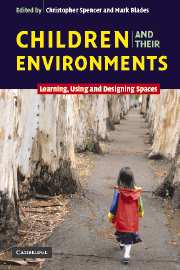Book contents
- Frontmatter
- Contents
- Notes on contributors
- An introduction
- Part I Children's understanding of places
- Part II Children's experience of places
- 5 Learning neighbourhood environments: the loss of experience in a modern world
- 6 The classroom environment and children's performance – is there a relationship?
- 7 ‘Sometimes birds sound like fish’: Perspectives on children's place experiences
- 8 Is contact with nature important for healthy child development? State of the evidence
- 9 Environmental child-friendliness in the light of the Bullerby Model
- Part III Adolescents' worlds?
- Part IV Children and the design process
- Index
- References
5 - Learning neighbourhood environments: the loss of experience in a modern world
Published online by Cambridge University Press: 23 October 2009
- Frontmatter
- Contents
- Notes on contributors
- An introduction
- Part I Children's understanding of places
- Part II Children's experience of places
- 5 Learning neighbourhood environments: the loss of experience in a modern world
- 6 The classroom environment and children's performance – is there a relationship?
- 7 ‘Sometimes birds sound like fish’: Perspectives on children's place experiences
- 8 Is contact with nature important for healthy child development? State of the evidence
- 9 Environmental child-friendliness in the light of the Bullerby Model
- Part III Adolescents' worlds?
- Part IV Children and the design process
- Index
- References
Summary
Maria loves cakes. She can always tell you which local cake shop has the freshest whipped cream, the richest cheese cake, the vanilla slice which melts in your mouth or the lightest puff pastry. She also knows which of these shops is nearest to home and which is furthest away, yet she can't explain to her friend, who lives in another part of the town, which of them would be her nearest cake shop.
Anna often takes her dog for a walk and she likes to let him wander off the lead. On one of their walks she discovered a car-free track between two rows of houses: an excellent shortcut for walking to school.
It's always David who decides where he and his friends will play football in their neighbourhood: he not only knows where, but also when to play so that the neighbours don't complain about the noise.
Mark stopped wanting to go to school on his own because of a menacing drunk he always encountered on the way. When Louis showed him another route, frequented by more people and with fewer risks, he was very relieved.
These fictitious, but plausible, examples illustrate some of the types of skills which form part of environmental competence. They also show the different types of relationships which exist between children and their everyday environment. What does knowing your own neighbourhood or, on a wider basis, the environment in which one lives, mean?
- Type
- Chapter
- Information
- Children and their EnvironmentsLearning, Using and Designing Spaces, pp. 75 - 90Publisher: Cambridge University PressPrint publication year: 2006
References
- 33
- Cited by



